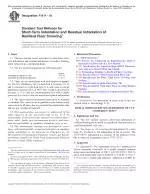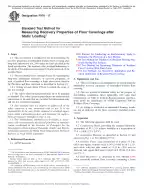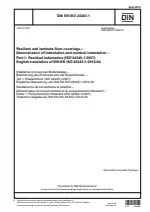ASTM F1914-18 PDF Download
Standard ENStandard Test Methods for Short-Term Indentation and Residual Indentation of Resilient Floor Covering
Also Known As:
The ASTM F1914-18 standard specifies test procedures for estimating short-term and long-term indentation of resilient floor coverings. These tests are designed to evaluate the floor covering's resistance to indentation and ability to bounce back, which are crucial for its proper functioning after installation.
For measuring indentation and residual indentation, the standard provides detailed instructions. A flat or spherical indentor is used to measure the indentation, which is done under a predetermined weight for a predetermined amount of time. After a predetermined recovery period, the residual indentation is measured.
Table 1 of the standard lists the testing and conditioning criteria for several types of resilient floor coverings. Based on the type of product, this table outlines the precise requirements and steps that must be taken.
The standard also specifies two distinct test-running techniques. The initial technique, referred to as the McBurney Test, is limited to a spherical foot and is solely employed to measure the initial indentation of Vinyl Composition Tile (VCT). The second method is used to measure both initial and residual indentation and is included in Sections 11 to 15 of the standard. It utilizes interchangeable feet with varied shapes.
| Descriptors | residual indentations, short-term indentations, McBurney apparatus, resilient floor coverings,Laboratory Apparatus,Mechanical Properties,Resilient Flooring |
| ICS Codes | 97.150 - Floor coverings |
| Language(s) | English |
| File Size | 194.6 KB |








